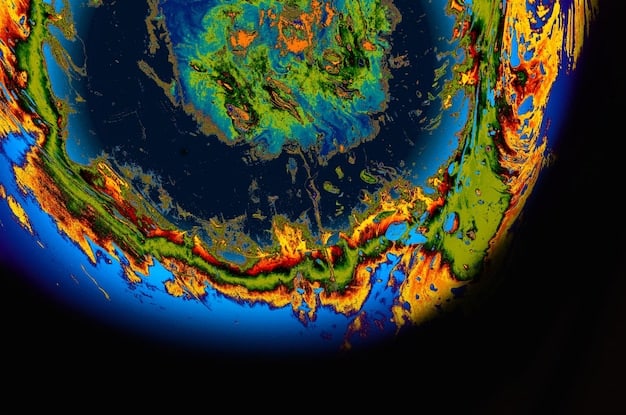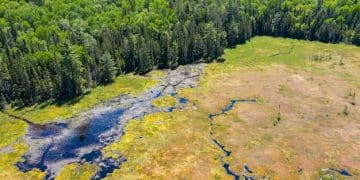Beyond the Headlines: Understanding the Real Impact of the Latest Climate Report

The latest climate report reveals critical insights beyond surface-level headlines, emphasizing the urgent need for a nuanced understanding of escalating global temperatures, extreme weather events, and their profound socio-economic implications on human societies and natural ecosystems, demanding immediate, coordinated action.
Delving into the complex layers of the most recent climate findings requires us to look beyond the headlines: understanding the real impact of the latest climate report. This is not merely about reciting alarming statistics but about grasping the interconnected consequences that reshape our world, demanding a deeper, more informed perspective from every individual and institution.
The Science Unveiled: What the Latest Report Truly States
The latest climate report, an aggregation of years of meticulous scientific research and data analysis, presents a stark, undeniable picture of Earth’s changing climate. It consolidates findings from thousands of studies, offering the most comprehensive assessment to date of global warming, its drivers, and its future projections. Understanding this report means moving beyond sensationalist news bytes to the core scientific consensus.
This critical document emphasizes that human activity remains the primary, unequivocal cause of observed warming trends. Industrial emissions, deforestation, and fossil fuel consumption continue to release greenhouse gases at unprecedented rates, trapping heat in the atmosphere. The report delineates the atmospheric concentration increases of carbon dioxide, methane, and nitrous oxide to levels not seen in hundreds of thousands of years, directly correlating with the rise in global average temperatures.
Attribution of Climate Change
One of the report’s strongest conclusions is the strengthened attribution of climate change to human influence. Advances in climate modeling and observational data have allowed scientists to isolate the human fingerprint on global warming with greater confidence than ever before. This removes any lingering scientific ambiguity about who or what is responsible for the current state of our planet.
- Increased accuracy in climate models linking human emissions to specific warming patterns.
- Observed changes in temperature, precipitation, and extreme events aligning with model predictions based on anthropogenic factors.
- Discernible differences between natural climate variability and the current rapid warming trend.
Moreover, the report details the observed changes across various earth systems: warming oceans, melting glaciers and ice sheets, and rising sea levels. These are not isolated phenomena but integrated components of a global system responding to increased energy absorption. The rate of these changes is a significant point of concern, indicating a swift departure from historical norms.
The report also dedicates substantial sections to examining climate feedback loops. For instance, as Arctic permafrost thaws, it releases vast quantities of trapped methane, a potent greenhouse gas, further accelerating warming. Similarly, the reduced reflectivity of melting ice lessens Earth’s ability to bounce solar radiation back into space, leading to more heat retention. These interconnected processes underscore the complexity and the potential for cascading impacts.
In essence, the science unveiled in this report is a complex tapestry woven from countless data points, observations, and computational models. It is a testament to global scientific collaboration, providing humanity with the clearest, most authoritative assessment of its current environmental trajectory. Dismissing these findings would be to ignore the collective wisdom of thousands of experts.
Beyond Temperature: The Spectrum of Climate Impacts
While global temperature rise is the most frequently cited metric of climate change, the true impact extends far beyond a simple number. The latest report meticulously details a broad spectrum of consequences that are already manifesting across the globe, affecting every facet of human and natural life. These impacts are interconnected, often exacerbating one another in complex ways.
Extreme weather events are a prime example. The report indicates a clear trend towards more frequent and intense heatwaves, prolonged droughts, devastating floods, and more powerful storms. These events are not isolated incidents but symptoms of a warmer, more energetic climate system. Their increasing regularity strains infrastructure, displaces communities, and overwhelms emergency services.
Impact on Ecosystems and Biodiversity
The natural world bears a significant brunt of these changes. Ecosystems, from coral reefs to boreal forests, are struggling to adapt to rapid shifts in temperature and precipitation patterns. Biodiversity loss is accelerating as species face habitat destruction, altered migratory routes, and an inability to cope with new environmental conditions. This not only diminishes the natural beauty of our planet but also compromises essential ecological services, such as pollination and water purification.
- Mass bleaching events in coral reefs due to ocean warming and acidification.
- Shifts in plant and animal geographic ranges, leading to new disease vectors and inter-species competition.
- Increased extinction rates as sensitive species fail to adapt to rapid environmental changes.
Ocean systems are also undergoing profound transformations. The report highlights continued ocean warming, acidification due to increased CO2 absorption, and deoxygenation. These changes severely impact marine life, from microscopic plankton foundational to the food web to commercially important fish species. Fishery collapses in certain regions are already evident, threatening livelihoods and food security.
Furthermore, the melting of glaciers and ice sheets contributes significantly to global sea level rise. This is not a distant threat but a present reality for countless coastal communities. Rising waters threaten infrastructure, displace populations, and lead to saltwater intrusion into freshwater sources, impacting agriculture and drinking water supplies. The report provides updated projections for sea level rise, indicating that even in optimistic scenarios, significant adaptation will be necessary.
The cumulative effect of these impacts is a disruption of natural cycles and human systems alike. Food security is jeopardized by unpredictable weather patterns, water scarcity becomes more pronounced in already arid regions, and public health is threatened by heat stress, air pollution, and the spread of vector-borne diseases. The report makes it clear that the climate crisis is not merely an environmental issue but a pervasive threat to global stability and well-being.
Socio-Economic Ripple Effects: More Than Just Environmental Concerns
The climate crisis, as illuminated by the latest report, is not solely an environmental challenge; it is a profound socio-economic disruptor with far-reaching consequences that ripple through every layer of society. Its impacts extend to economics, public health, migration, and geopolitical stability, demanding a holistic understanding of the problem.
Economically, the costs associated with climate change are spiraling upwards. Direct damages from extreme weather events, such as hurricanes, floods, and wildfires, amount to billions of dollars annually. Beyond immediate damage, there are indirect costs stemming from supply chain disruptions, decreased agricultural productivity, and the strain on public services. Infrastructure, from transportation networks to energy grids, faces unprecedented stress, requiring massive investments in adaptation and resilience.
Public Health Imperatives
The report underscores that public health is increasingly vulnerable. Heat-related illnesses and deaths are on the rise, particularly among vulnerable populations. Changes in vector-borne disease patterns, such as malaria and dengue, are expanding their geographical reach. Air quality deteriorates due to increased wildfires and ground-level ozone, exacerbating respiratory and cardiovascular conditions. Mental health impacts from climate anxiety and displacement are also emerging as significant concerns, indicating a broad public health crisis.
- Increased incidence of heatstroke and dehydration in urban areas.
- Expanded range of mosquito-borne diseases due to warmer temperatures.
- Mental health challenges, including anxiety and depression, linked to climate change impacts.

Climate change also acts as a powerful driver of migration and displacement. As traditional livelihoods collapse due to drought, desertification, or sea-level rise, communities are forced to move, often internally or across borders. This creates humanitarian crises, strains resources in host regions, and can fuel social unrest. The report highlights how climate change exacerbates existing vulnerabilities, disproportionately affecting the poor and marginalized who have contributed least to the problem.
Geopolitically, competition over dwindling resources such as freshwater and arable land could escalate conflicts. Climate-induced instability in one region can have spillover effects globally, impacting international relations and security frameworks. The report implicitly suggests that collaborative international efforts are essential not just for climate mitigation but for maintaining global peace and stability.
Furthermore, the economic transition required to move away from fossil fuels presents both challenges and opportunities. While some industries may decline, new green technologies and sectors are emerging, promising economic growth and job creation. However, managing this transition equitably, ensuring that no communities are left behind, is a critical socio-economic challenge that the report hints at, requiring careful policy planning and investment.
In sum, the socio-economic ripple effects of climate change are pervasive and profound. They demand a shift in perspective, recognizing that climate action is not just about protecting the environment but about safeguarding human prosperity, health, and stability. Ignoring these interwoven complexities is to underestimate the true nature of the crisis outlined in the latest climate report.
The Imperative for Action: Mitigation and Adaptation Strategies
The latest climate report functions not just as a diagnostic tool but as a clarion call for urgent and transformative action. It unequivocally stresses the critical need for both vigorous mitigation – reducing greenhouse gas emissions – and robust adaptation – adjusting to the impacts already underway. These two approaches are complementary and mutually reinforcing, neither sufficient on its own.
Mitigation is primarily focused on reducing the amount of greenhouse gases entering the atmosphere. This involves a comprehensive transformation of global energy systems, moving away from fossil fuels towards renewable sources like solar, wind, and geothermal energy. Decarbonizing industries, improving energy efficiency in buildings and transportation, and exploring carbon capture technologies are also vital components.
Key Mitigation Pathways
- Rapidly scaling up renewable energy infrastructure and discontinuing new fossil fuel projects.
- Implementing policies that promote energy efficiency across all sectors, from industrial processes to residential consumption.
- Enhancing carbon sinks through afforestation, reforestation, and sustainable land management practices.
Parallel to mitigation, adaptation strategies are crucial. Since some level of climate change is already locked in due to past emissions, communities and nations must prepare for inevitable impacts. This includes developing early warning systems for extreme weather, building resilient infrastructure, managing water resources more efficiently, and promoting climate-resilient agriculture.
The report highlights that the pace and scale of current mitigation efforts are insufficient to meet the goals set out in the Paris Agreement, particularly the 1.5°C target. It warns that every fraction of a degree matters, as it significantly reduces the likelihood of triggering irreversible tipping points, such as the collapse of major ice sheets or widespread ecosystem degradation. This ‘do-or-die’ framing underscores the urgency of accelerating global efforts.
Furthermore, the report emphasizes the importance of international cooperation. Climate change respects no borders, and effective solutions require a coordinated global response. Technology transfer from developed to developing nations, financial support for climate action in vulnerable countries, and collective policy frameworks are essential to ensuring an equitable and effective transition.
It also touches upon the concept of “loss and damage,” acknowledging that some impacts are now unavoidable and disproportionately burden vulnerable nations. This calls for mechanisms to address the financial and non-financial costs suffered by countries severely affected by climate change, a key point of discussion in international climate negotiations.
Ultimately, the imperative for action presented by the report is not just about avoiding future catastrophe but about seizing opportunities for sustainable development. Investing in green economies, fostering innovation, and building resilient communities can lead to improved public health, increased energy security, and greater social equity. The report’s message is clear: the time for decisive, transformative action is now, and it requires commitment at every level of society.
The Role of Governance and Policy in Climate Solutions
The latest climate report makes it unequivocally clear that individual actions, while important, are insufficient to address the scale of the climate crisis. Transformative change hinges on robust governance and coherent policy frameworks enacted at local, national, and international levels. These structures provide the necessary incentives, regulations, and investments to steer societies towards a sustainable future.
Effective climate governance involves setting ambitious targets, implementing legal and regulatory mechanisms to achieve them, and ensuring accountability. This includes carbon pricing schemes (taxes or cap-and-trade systems), renewable energy mandates, efficiency standards for industries and appliances, and regulations on land use and deforestation. Policies aimed at phasing out fossil fuel subsidies and redirecting investments towards green technologies are also crucial.
International Cooperation and Diplomacy
On the international stage, climate diplomacy plays a pivotal role. Agreements like the Paris Agreement provide a framework for global cooperation, setting collective goals and requiring nations to submit nationally determined contributions (NDCs). The report implicitly urges stronger NDCs and greater adherence to commitments, underscoring that global emissions trajectories are still far from aligned with desirable climate outcomes.
- Strengthening international agreements and enforcement mechanisms for climate commitments.
- Facilitating technology transfer and financial assistance from wealthier to developing nations for climate action.
- Promoting multilateral dialogues and partnerships to address cross-border climate challenges.

National governments are instrumental in translating international ambitions into domestic action. This includes developing national climate plans, integrating climate considerations into all sectors of policy-making (energy, transport, agriculture, urban planning), and allocating sufficient budget for climate-related initiatives. The report points to the uneven progress across countries, highlighting the need for accelerated policy implementation in many regions.
Local governance also holds significant power. Cities, regional authorities, and indigenous communities often lead the way in implementing climate solutions tailored to their specific contexts. Policies around urban planning, public transport, waste management, and local renewable energy projects can significantly contribute to emission reductions and enhance community resilience. The report recognizes the importance of multi-level governance, where actions at different scales reinforce each other.
Furthermore, transparent monitoring, reporting, and verification systems are vital to track progress and ensure accountability. The report reinforces the need for robust scientific assessment to inform policy decisions, highlighting the critical interface between science and policy. Policymakers must rely on the best available science to make informed choices, and scientists need to communicate their findings effectively to decision-makers.
In essence, the latest climate report underscores that overcoming the climate crisis is largely a battle of policy and political will. It calls for visionary leadership, effective governance structures, and robust international cooperation to translate scientific understanding into decisive action, ensuring a livable and sustainable future for all.
Future Scenarios and Pathways: Navigating Uncertainty
The latest climate report doesn’t just reveal our current predicament; it offers a range of future scenarios, from the optimistic to the alarmingly dire, based on different levels of greenhouse gas emissions. These pathways are not predictions but projections, illustrating the profound influence of current and future human choices on the planet’s trajectory. Understanding these scenarios is crucial for strategic planning and decision-making.
The report outlines several shared socio-economic pathways (SSPs), each representing a plausible future development of human society, including demographic, social, and economic trends. These SSPs are combined with climate models to project different warming outcomes. For instance, a high-emission scenario depicts a world where fossil fuel use continues unabated, leading to catastrophic warming, while a low-emission scenario assumes rapid decarbonization and significant climate action.
Implications of Tipping Points
A particularly concerning aspect of future scenarios involves the concept of “tipping points.” These are thresholds beyond which certain components of the Earth’s climate system can undergo abrupt and irreversible changes with potentially devastating consequences. The report highlights the increasing risk of triggering such points if warming continues unchecked, emphasizing the urgency of staying below critical temperature thresholds.
- Potential for irreversible melting of major ice sheets, leading to meters of sea level rise.
- Risk of Amazon rainforest dieback, transforming it from a carbon sink to a carbon source.
- Weakening of ocean currents, like the Atlantic Meridional Overturning Circulation (AMOC), impacting regional climates.
Even under the most ambitious mitigation scenarios, some degree of warming and its associated impacts are now unavoidable for several decades due to the inertia of the climate system. This means adaptation will remain a critical necessity regardless of future emission reductions. The report stresses that the severity of future impacts is directly proportional to how quickly and drastically emissions are reduced from now on.
The projections also detail regional variations in future climate impacts. Some areas are predicted to experience more severe heatwaves, while others face increased flooding or prolonged droughts. This geographical specificity is vital for local and national governments to develop tailored adaptation plans, acknowledging that climate change is experienced differently across the globe.
The report also touches upon climate feedbacks—processes that can amplify or diminish initial warming. For example, as the Earth warms, the capacity of natural carbon sinks (like oceans and forests) to absorb CO2 may decrease, leading to more atmospheric CO2 and further warming. These complex interactions introduce additional uncertainties into future projections, reinforcing the need for precautionary action.
In summary, the future scenarios presented in the latest climate report offer a powerful range of possibilities, from a world grappling with severe, widespread climate disruptions to one that has successfully navigated the transition to sustainability. These pathways underscore that while the future is uncertain, it is largely determined by the choices we make today, offering a crucial navigational tool for global action.
| Key Point | Brief Description |
|---|---|
| 🔬 Science is Clear | Human activities are unequivocally driving climate change, reaching unprecedented levels of greenhouse gas concentrations. |
| 🌍 Broad Impacts | Beyond temperature, impacts include extreme weather, ecosystem disruption, biodiversity loss, and ocean changes. |
| 💰 Socio-Economic Costs | Climate change poses significant economic costs, public health risks, and can drive migration and geopolitical instability. |
| ⚡ Action Imperative | Urgent, transformative action is needed for both mitigation (emission reduction) and adaptation to inevitable changes. |
Frequently Asked Questions
The report’s central message is that climate change is unequivocally human-caused and widespread, affecting every region. It emphasizes that observed changes are unprecedented in thousands of years and that deep, rapid, and sustained reductions in greenhouse gas emissions are urgently needed to avert the most catastrophic outcomes. It serves as a scientific consensus on the state of the climate crisis and pathways forward.
The report leverages advanced climate models and extensive historical data to disentangle human-induced changes from natural climate cycles. It demonstrates that the current rate and magnitude of warming, the specific atmospheric changes, and the frequency of extreme weather events cannot be explained by natural factors alone. The human “fingerprint” is evident in observed patterns, providing high confidence in attribution.
Tipping points refer to critical thresholds in the Earth’s climate system where a small additional amount of warming can lead to abrupt, often irreversible, and large-scale changes. Examples include the collapse of major ice sheets, widespread dieback of rainforests, or changes in ocean circulation. The report warns that these points become increasingly likely at higher warming levels, posing significant risks.
Mitigation (reducing emissions) is crucial to limit future warming and prevent worsening impacts. However, even with aggressive mitigation, some degree of climate change and its effects are already locked in due to past emissions. Therefore, adaptation (adjusting to impacts) is equally vital to protect communities, infrastructure, and ecosystems from the unavoidable consequences. Both strategies are complementary for a resilient future.
The report highlights that climate change is not just an environmental issue but a profound socio-economic challenge. It impacts livelihoods, public health, food and water security, and can exacerbate poverty and inequality. Conversely, ambitious climate action aligns with sustainable development goals, offering opportunities for green job creation, technological innovation, and improved well-being, demonstrating a critical interdependency.
Conclusion
The latest climate report serves as a definitive and urgent synthesis of scientific understanding, transcending mere headlines to illuminate the profound and interconnected challenges humanity faces. It underscores the undeniable human influence on a warming planet, detailing a spectrum of escalating impacts that extend far beyond temperature, permeating socio-economic structures, health systems, and geopolitical stability. This comprehensive assessment leaves no room for complacency, emphasizing that while the situation is dire, transformative action—through aggressive mitigation and strategic adaptation, bolstered by robust governance and international cooperation—remains within reach. The report is an invaluable tool, not just for understanding our present climate crisis, but for charting decisive, collective pathways toward a more sustainable and resilient future.





